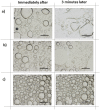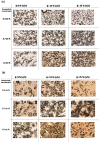Nanoparticle and gelation stabilized functional composites of an ionic salt in a hydrophobic polymer matrix
- PMID: 24516593
- PMCID: PMC3916421
- DOI: 10.1371/journal.pone.0088125
Nanoparticle and gelation stabilized functional composites of an ionic salt in a hydrophobic polymer matrix
Abstract
Polymer composites consisted of small hydrophilic pockets homogeneously dispersed in a hydrophobic polymer matrix are important in many applications where controlled release of the functional agent from the hydrophilic phase is needed. As an example, a release of biomolecules or drugs from therapeutic formulations or release of salt in anti-icing application can be mentioned. Here, we report a method for preparation of such a composite material consisted of small KCOOH salt pockets distributed in the styrene-butadiene-styrene (SBS) polymer matrix and demonstrate its effectiveness in anti-icing coatings. The mixtures of the aqueous KCOOH and SBS-cyclohexane solutions were firstly stabilized by adding silica nanoparticles to the emulsions and, even more, by gelation of the aqueous phase by agarose. The emulsions were observed in optical microscope to check its stability in time and characterized by rheological measurements. The dry composite materials were obtained via casting the emulsions onto the glass substrates and evaporations of the organic solvent. Composite polymer films were characterized by water contact angle (WCA) measurements. The release of KCOOH salt into water and the freezing delay experiments of water droplets on dry composite films demonstrated their anti-icing properties. It has been concluded that hydrophobic and thermoplastic SBS polymer allows incorporation of the hydrophilic pockets/phases through our technique that opens the possibility for controlled delivering of anti-icing agents from the composite.
Conflict of interest statement
Figures









References
-
- Akartuna I, Tervoort E, Studart AR, Gauckler LJ (2009) General Route for the Assembly of Functional Inorganic Capsules. Langmuir 25: 12419–12424. - PubMed
-
- Akartuna I, Tervoort E, Wong J, Studart AR, Gauckler LJ (2009) Macroporous polymers from particle stabilized emulsions. Polymer 50: 3646–3651.
-
- Aranberri I, Binks BP, Clint JH, Fletcher PDI (2009) Synthesis of macroporous silica from solid-stabilised emulsion templates. Journal of Porous Materials 16: 429–437.
-
- Binks BP (2002) Macroporous silica from solid-stabilized emulsion templates. Advanced Materials 14: 1824–1827.
-
- Busby W, Cameron NR, Jahoda ABC (2002) Tissue engineering matrixes by emulsion templating. Polymer International 51: 871–881.
Publication types
MeSH terms
Substances
LinkOut - more resources
Full Text Sources
Other Literature Sources
Research Materials

